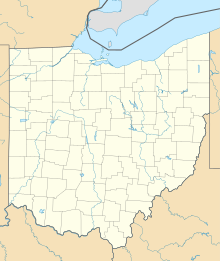Rickenbacker International Airport
| Rickenbacker International Airport | |||||||||||||||
|---|---|---|---|---|---|---|---|---|---|---|---|---|---|---|---|
 |
|||||||||||||||
 |
|||||||||||||||
| Summary | |||||||||||||||
| Airport type | Public | ||||||||||||||
| Operator | Columbus Regional Airport Authority | ||||||||||||||
| Serves | Columbus, OH | ||||||||||||||
| Location | Franklin / Pickaway counties, near Columbus, Ohio | ||||||||||||||
| Hub for | |||||||||||||||
| Elevation AMSL | 744 ft / 227 m | ||||||||||||||
| Coordinates | 39°48′50″N 082°55′40″W / 39.81389°N 82.92778°W | ||||||||||||||
| Website | www.rickenbacker.org | ||||||||||||||
| Map | |||||||||||||||
| Location of airport in Ohio / United States | |||||||||||||||
| Runways | |||||||||||||||
|
|||||||||||||||
| Statistics (2012) | |||||||||||||||
|
|||||||||||||||
|
Source: Federal Aviation Administration
|
|||||||||||||||
| Aircraft operations | 39,436 |
|---|---|
| Based aircraft | 28 |
Rickenbacker International Airport (IATA: LCK, ICAO: KLCK, FAA LID: LCK) is a civil-military public airport 10 miles (16 km) south of downtown Columbus, near Lockbourne in southern Franklin County, Ohio, United States. The south end of the airport extends into Pickaway County. The base was named for flying ace and Columbus native Eddie Rickenbacker. It is managed by the Columbus Regional Airport Authority, which also operates Port Columbus International Airport and Bolton Field. Rickenbacker International is primarily a cargo airport for the city of Columbus, although since 2012 it has served an increasing number of passenger flights as well as charter carriers.
The United States Air Force maintains a presence in the form of the Ohio Air National Guard's 121st Air Refueling Wing, Rickenbacker International is also home of the Ohio Army National Guard's Army Aviation Support Facility No. 2 and the headquarters for the Ohio Military Reserve, one of the state defense forces of Ohio.
The facility opened in June 1942 as Lockbourne Army Airfield (named after the nearby village of Lockbourne). It was then named the Northeastern Training Center of the Army Air Corps, and provided basic pilot training and military support. In addition, the training center provided B-17 flight training to the Women Airforce Service Pilots (WASPs), and training for glider pilots in the CG-4A Waco glider. After the war, flight-training activities were halted and the airfield was used as a development and testing facility for all-weather military flight operations. The primary unit at the base was the all-Black 447th Composite Group, also known as the Tuskegee Airmen.
...
Wikipedia


